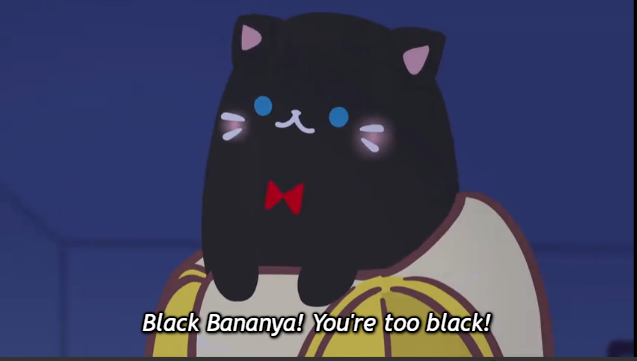Modern technology has brought with it the democratization of the arts. Once the domain of kings and religious institutions, the internet allows art to be created and discussed by all. This domain is a platform for a new age of patrons to forge hitherto neglected ideas into reality.
Though Bananya is only 13 three-minute episodes long (a side effect of its crowd-funded origins), the show will linger long in the hearts and minds of its viewers. In what can only be described as the I, Claudius of the cartoon cat genre, the show encapsulates the struggle for personal identity in an increasingly superficial world.
For those unfamiliar with Bananya, but who want to participate in this dialogue, it can be viewed for free at the link here. (Note: all images used in this post are taken from this link.)
One could be forgiven for believing that Bananya merely tells the tales of a carefree group of cats who adorably live out their lives hopping around in bananas, but behind this premise lies a deeper meaning. The story uses our titular protagonist as an everyman with whom we are meant to connect. Bananya is a a fun-loving cat who enjoys sweets and is driven to achieve his dreams, much like the youth of today. That his dream is to become a chocolate-covered Bananya further serves to develop his uniqueness and authenticity.
 |
| May our own dreams be as noble. |
Initially, this world appears to be idyllic, with happy cats enjoying their lives as they bounce about with reckless abandon all while encased in fruit. Quickly, though, the cracks begin to show. It is revealed in an early episode that the lone female Bananya is self-conscious and uses heavy amounts of makeup to maintain her appearance. It is clear that these adorable cats have fears and anxieties similar to ours as humans. Through this, the world we are viewing begins to seem closer to our own.
 |
| Only the white parts, so not much. |
Our protagonist's dream appears to be derived from this culture. In the third episode, Bananya is shown to quite literally worship the chocolate-covered bananas on the television, suggesting that advertising is the origin of his motivations. The cheap but ubiquitous tactic of purveying sex appeal for the sake of profit is also on display as stereotypical trappings of societal gender constructs are used to draw the unsuspecting cat in and deprive him of his self-determination.
 |
| Pictured: A cat trying to motorboat a television |
This cultural pressure is further alluded to in Bananya's friendship with a mouse in episode four. So long as Bananya is on his own, the friendship remains, but as soon as another cat is brought into the situation, Bananya falls victim to peer pressure, much to the chagrin of the mouse.
 |
| Chagrin = Terror |
 |
| "I've seen enough hentai to know where this is going." |
In a world with innumerable individuals, all with their own story to be told, how can we hope to understand others in a finite lifetime? Simplification allows an easier-to-understand narrative, but something is always lost in the process. The greater risk is that through this process, the whole will be lost and we will be left with tenuous fragments of experience akin to Baby Bananya rapidly changing the channel.
This is further exemplified by the problematic interaction with Black Bananya. Walking through the house late at night, the various Bananyas become terrified, believing that danger lurks in the darkness. When it is at last revealed that the shadowy figure was only Black Bananya, the narrator makes a crude joke for humorous affect.
The insensitivity displayed by this offhand remark is contrasted when, at the end of the episode, it is revealed that he is a cultured cat who hails from France and loves fine wine and food.
While the narrator is quick to defend his joke through this portrayal, these details do little more than create additional questions around issues such as Western hegemony and colonial imperialism. Furthermore, Black Bananya does not protest this treatment, suggesting that these experiences are so commonplace that he lacks an internal locus of control in a society that has institutionalized his mistreatment.
Clearly, the internal worlds we create are fraught with error due to the limitation of time. This then begs the question: can these internal models be reconciled with the external world, or will we forever be adrift from others like ships passing in the night?
Bananya as a show clearly takes the latter viewpoint. In episode eight, Bananya encounters a regular-sized cat who does not live in a banana. In this scene, the stray cat urges Bananya to open the window and let him in; Bananya comes close to doing so, but eventually falls asleep, closing the curtain (literally) on this scene. The house represents our internal world with the window acting as the lens with which we view our surroundings. These worlds cannot be reconciled, but so long as we give this no thought, peace can be achieved, as it is with Bananya when he falls asleep at the end of the episode.
It is clear that, according to Bananya, the external world cannot give us meaning, for at its core, it is a world that isolates us and prevents us from achieving the true human (cat?) connection we all crave. Can we leap this chasm, or are we forever left hiding in our peel? Left to ponder the implications of this, what more can be said except woe, woe unto Bananya. For in this world, all is vanity and chasing after the wind.
What is your favorite show involving cats? Sound off in the comments section below.






0 comments:
Post a Comment